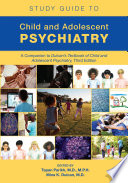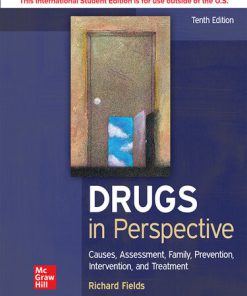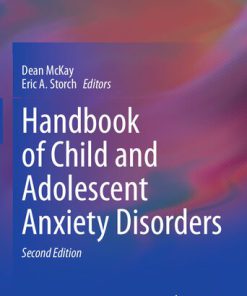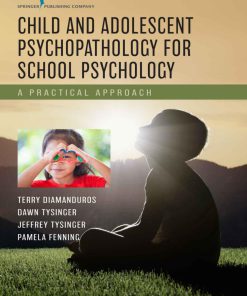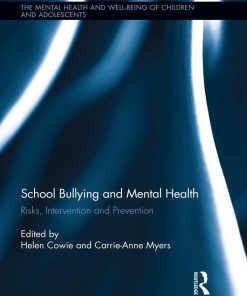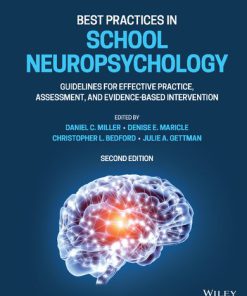Child and adolescent suicidal behavior school based prevention assessment and intervention 2nd Edition by David N Miller ISBN 9781462546596 1462546595
$50.00 Original price was: $50.00.$25.00Current price is: $25.00.
Child and adolescent suicidal behavior school based prevention assessment and intervention 2nd Edition by David N Miller – Ebook PDF Instant Download/Delivery: 9781462546596, 1462546595
Full download Child and adolescent suicidal behavior school based prevention assessment and intervention 2nd Edition after payment

Product details:
ISBN 10: 1462546595
ISBN 13: 9781462546596
Author: David N Miller
Child and adolescent suicidal behavior school based prevention assessment and intervention 2nd Edition Table of contents:
1. Suicidal Behavior in Children and Adolescents: An Introduction and Overview
Suicide and Schools
Suicidal Behavior
Suicidal Ideation
Suicide-Related Communications
Suicide Attempts
Suicide
Words Matter
Summary
Youth Suicidal Behavior: The Scope of the Problem
Youth Suicide in Perspective
Demographics of Youth Suicide
Race and Ethnicity
Age
Sex
Sexual Orientation and Gender Identity
Geography
Socioeconomic Status
Common Myths and Misconceptions about Youth Suicide
Myth: Talking or Asking About Suicide Will Increase the Probability of Its Occurrence
Myth: Parents/Caregivers Are Cognizant of Their Child’s Suicidal Behavior
Myth: Most Youth Who Attempt Suicide Receive Some Form of Treatment
Myth: Most Young People Who Die by Suicide Leave Suicide Notes
Myth: Suicidal People Are Impulsive
Myth: Young Children Are Not Suicidal
Myth: Suicide Rates Increase in December
Myth: If Someone Is Suicidal, There Is Little or Nothing That Can Be Done to Prevent It
Other Common Myths about Suicide
Youth Suicide: When, Where, and How
When Is Youth Suicide Most Likely to Occur?
Where Is Youth Suicide Most Likely to Occur?
How Is Youth Suicide Most Likely to Occur?
The Big Question: Why Do Young People Die by Suicide?
Early Theories of Suicidal Behavior
Later Theories of Suicidal Behavior
Contemporary Ideation-to-Action Theories of Suicide
Joiner’s Interpersonal Theory of Suicide
Klonsky and May’s Three-Step Theory of Suicide
Pain, Suffering, and Cognition
The Importance of Reducing Suffering in Suicidal Youth
Science, Pseudoscience, and Suicide Prevention
Concluding Comments
2. Youth Suicidal Behavior and the Schools
Suicide Prevention in Schools: A Brief History
Evaluating School-Based Suicide Prevention Programs
Effective Elements of School-Based Suicide Prevention
Ineffective Elements to Avoid
Suicide Prevention in the Miami–Dade County Public School District
Components of Comprehensive School-Based Suicide Prevention Programs
Why Should Schools Be Involved in Suicide Prevention?
Liability Issues, Legislative Outcomes, Ethical Responsibilities, and Best Practices
Liability Issues
Legislation
Ethical Responsibilities
Best Practices
Concluding Comments
3. Teamwork, Roles and Responsibilities, and Self-Care in Schools
School District Policies and Procedures for Suicide Prevention
Gatekeeper: The Role and Responsibility of All School Personnel
What to Say
What Not to Say
Roles and Responsibilities of Teachers
Roles and Responsibilities of the CSPT
Conducting Effective CSPT Meetings
Crisis Response and the CSPT
Care for the Caregivers: Self-Care for School Personnel
Managing Stress and Preventing Burnout
Personal Self-Care Strategies
Professional Self-Care Strategies
Organizational Self-Care Strategies
Concluding Comments
4. Public Health Approaches to Youth Suicide Prevention
Suicide as a Public Health Problem
Public Health: A Brief Overview
Community-Based Public Health Approaches to Suicide Prevention
Means Safety
Crisis Hotlines
The Internet, Social Media, and Other Electronic Communication Devices
Public Education about Suicide
The U.S. Air Force Model of Suicide Prevention
Mental Health as a Component of Public Health
Applying the Public Health Approach to Schools
Population-Based Mental Health Approaches
Prevention
Health Promotion
Evidence-Based Practices
Multi-Tiered Systems of Support in Schools
Mental Health, Public Health, Public Policy, and the Schools
Concluding Comments
5. Tier 1 School-Based Suicide Prevention Programs for All Students
Information on Youth Suicide for All Students and Staff
Demographic Information
Myths and Realities
Variables That Help Explain or Predict Youth Suicidal Behavior
Risk Factors
Presence of Mental Health Disorders
Previous Suicidal Behavior
Other Risk Factors
Possible Warning Signs of Suicidal Behavior
Precipitants: Situational Crises and Stressful Life Events
Protective Factors
Teaching Students How and Where to Get Help
Limitations of Student Curriculum Programs
Other Tier 1 Suicide Prevention Programs in Schools
Good Behavior Game
Sources of Strength
SOS Signs of Suicide
Lifelines Curriculum
Youth Aware of Mental Health Programme
DBT Skills Training for Emotional Problem Solving for Adolescents
Maximizing Tier 1 Suicide Prevention Program Effectiveness: The Importance of School Climate, School
Praise and Other Strategies for Improving School Climate
Concluding Comments
6. Identifying Tier 2 and Tier 3 Students and Linking Assessment to Intervention
Screening
Linking Suicide Risk Assessment to Intervention
An Overview of Suicide Screening Programs
Advantages of School-Based Suicide Screening Programs
Challenges in Implementing School-Based Suicide Screening Programs
Ethical and Legal Issues in Student Screening
Screening Summary
Other Procedures for Identifying Potentially At-Risk Youth
Identification Based on Demographics and Risk Factors
Identification Based on Referrals from Students or School Staff
Conducting Individual Student Suicide Risk Assessments
The Purposes of School-Based Suicide Risk Assessments
Low Risk
Moderate Risk
High Risk
No Risk
Basic Principles of Youth Suicide Risk Assessment
Risk Can Be Understood
Risk Is Not Static, and Assessment Must Be Ongoing
Risk Does Not Always “Shout Out”
Multiple Informants Facilitate a Comprehensive Assessment
Interviewing Children and Adolescents
Engage in Self-Reflection Prior to Conducting Student Interviews
Establish Rapport and Make the Student Feel as Comfortable as Possible
Overcome Common Fears
Let the Student Know the Purposes and Parameters of the Interview
Show That You Care and Exhibit a Willingness to Help
Be Affirmative and Encouraging and Acknowledge Courage
Allow Students to Tell Their Story
Be Cognizant of Obstacles to Disclosure
Resist the Urge to Persuade or Offer Advice
Be Aware of Developmental Issues, Especially When Interviewing Children
Ask Specific and Direct Questions
Distinguish Words from Behavior
Prioritize Warning Signs over Risk Factors
Assess Acquired Capability for Suicide
Assess Access to Firearms
Assess Use of the Internet and Social Media
Assess Protective Factors
Document the Interview
Interviewing Teachers and Other School Personnel
Interviewing Parents or Caregivers
Assessment Procedures to Avoid
Special Topics in Suicide Risk Assessment
Suicide and Nonsuicidal Self-Injury
Suicide and Bullying
Suicide and Homicide: Murder–Suicide and School Shootings
Enhancing Professional Skills in Suicide Risk Assessment
Concluding Comments
7. Tier 2 and Tier 3 Interventions for At-Risk and High-Risk Students
Interventions for Low-Risk Students
Interventions for Moderate-Risk Students
School-Based Suicide Intervention Programs for At-Risk Students
American Indian Life Skills Development Program
Reconnecting Youth
Other School-Based Tier 2 Interventions for At-Risk Students
Interventions for Depression, Anxiety, and Hopelessness
Interventions for Conduct Problems
Interventions for Substance Abuse Problems
Interventions for Increasing Connectedness
Interventions for High-Risk Students
Removing Access to Lethal Means
Keeping the Student Safe
Breaking Confidentiality
Making Use of Safety Plans Rather Than No-Suicide Contracts
Communicating and Collaborating with Parents or Caregivers
Communicating and Collaborating with Community Supports
Documentation
Preparing for the Student’s Return to School
Other Tier 3 Interventions for Suicidal Youth
Increasing Contact
Dialectical Behavior Therapy
Hospitalization
Psychopharmacological Interventions
Concluding Comments
8. School-Based Suicide Postvention
The Importance of Preparedness
Principles Guiding Suicide Postvention in Schools
Suicide Postvention MTSS
Developing a Protocol to Respond to Student Suicide
Steps for Developing a School-Based Suicide Postvention Protocol
Convene a Group to Create the Protocol
Identify Community Partners Who Can Help
Create a Protocol for Your School’s Immediate Response to a Suicide
Include the Immediate Response Protocol in Your School’s Crisis Response Plan
Create a Protocol for a Long-Term Response to a Suicide
Help the Staff Understand the Protocol
Update the Protocol
A School-Based Suicide Postvention Protocol
Verify That a Death Has Occurred
Mobilize the CSPT
Designate a Media Spokesperson
Use and Monitor Social Media
Contact the Student’s Family to Express Condolences and Offer Support
Discuss Issues Related to the Suicide and the School’s Response with Parents
Address Any Uncertainty or Rumors about the Cause of Death
Address Cultural Diversity Issues
Notify School Personnel and Conduct a Planning Session
Assess the Impact of the Suicide on the School and the Required Level of Response
Identify Students Significantly Affected by the Suicide and Initiate a Referral Mechanism
Notify Students
Engage in Normal Instructional Practices When Appropriate
Help Students Cope
Have Mental Health Professionals Visit Classrooms
Initiate Crisis Intervention Services
Conduct Daily Planning Sessions
Debrief School Personnel
Evaluate the Postvention Response and Prepare for the Long-Term Response
Provide Ongoing Support for Grieving Students
Plan for Anniversaries
Follow Up with the Family in the Weeks and Months after the Suicide
Suicide Contagion and Clusters
Media-Related Suicide Contagion
Guidelines for Working with the Media
Preventing Suicide: A Resource for Media Professionals
Reportingonsuicide.org
After a Suicide: A Toolkit for Schools
Positive Aspects of Media Coverage
Responding to a Student Suicide That Occurs at School
Responding to the Suicide of an Adult Staff Member
Memorialization and the School’s Response
Funerals and Memorial Services
Spontaneous Memorials
Online Memorials
School Newspapers
Events
Yearbooks
Graduation
Permanent Memorials and Scholarships
Suggestions for Safe Memorialization
Additional Information on Suicide Postvention in Schools
Beyond the Schools: The Ripple Effects of Suicide
Concluding Comments
Epilogue
Curing and Healing
Breaking Barriers
A Preventable Problem and Unnecessary Tragedy
People also search for Child and adolescent suicidal behavior school based prevention assessment and intervention 2nd Edition:
child and adolescent behavioral health summit
how to become a child behavioral therapist
child and adolescent psychiatry san antonio
behavioral schools for 10 year olds
adolescent suicidal behavior
Tags: David N Miller, suicidal behavior school, prevention assessment, intervention
You may also like…
Medicine - Psychiatry
Science (General)
Medicine - Others
Psychology - Clinical Psychology
Psychology - Psychopathy
Child and Adolescent Psychopathology for School Psychology Terry Diamanduros
Psychology - Pedagogy
Psychology - Neuropsychology
Psychology - Psychological Disorders
Child and Adolescent Psychopathology 3rd Edition Theodore P. Beauchaine



